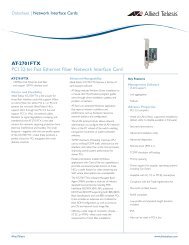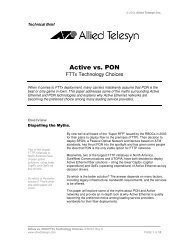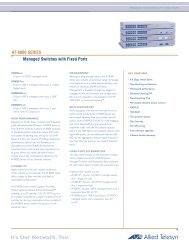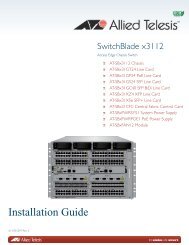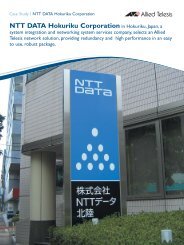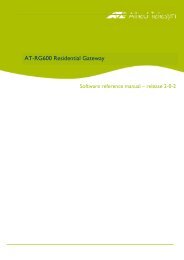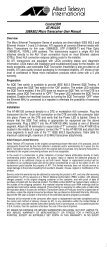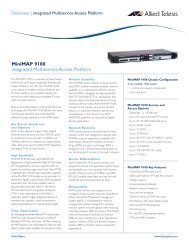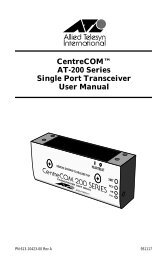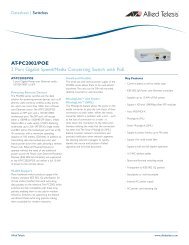AT-3624TR/3648TR Installation Manual - Allied Telesis
AT-3624TR/3648TR Installation Manual - Allied Telesis
AT-3624TR/3648TR Installation Manual - Allied Telesis
Create successful ePaper yourself
Turn your PDF publications into a flip-book with our unique Google optimized e-Paper software.
Glossary<br />
BAYONET NUT COUPLE (BNC) CONNECTOR—A 10BASE2 thin coax<br />
connector with push-on BNC locking lug that quickly locks into place with a half<br />
twist.<br />
BIT R<strong>AT</strong>E (BR)—The rate of data throughput on the medium in bits per second.<br />
Ethernet specifies 10 million bits per second.<br />
BIT TIME—The duration of one bit symbol (1/BR). Ethernet specifies a bit time<br />
of 100 ns.<br />
CARRIER SENSE—In a LAN, an ongoing activity of a data station to detect<br />
whether another station is transmitting.<br />
CARRIER SENSE MULTIPLE ACCESS with COLLISION DETECT<br />
(CSMA/CD)—This is the access method employed by IEEE 802.3 LAN<br />
transceivers, by which multiple stations compete for use of the transmission<br />
medium (coax cable) for data packet transmission. It provides for a level of error<br />
detection should that transmission be corrupted or impeded by contention for the<br />
transmission medium.<br />
COAX SEGMENT—A segment of Ethernet cable that contains MAUs.<br />
COAXIAL CABLE—A two-conductor (center conductor, shield system),<br />
concentric, constant impedance transmission line used as the trunk medium in the<br />
baseband system.<br />
COAXIAL CABLE SEGMENT—A length of coaxial cable sections and coaxial<br />
connectors, terminated at each end in its characteristic impedance.<br />
COLLISION—An unwanted condition that results from concurrent<br />
transmissions on the physical medium.<br />
COMP<strong>AT</strong>IBILITY INTERFACE—The MDI coaxial cable interface and the<br />
AUI branch cable interface, the two points at which hardware compatibility is<br />
defined to allow connection of independently designed and manufactured<br />
components to the baseband transmission system.<br />
CROSSOVER—Wiring used when connecting a 10BASE-T MAU to another<br />
10BASE-T MAU or a 10BASE-T hub to another 10BASE-T hub. For example, one<br />
10BASE-T MAU has the TD pair on the same pins as another 10BASE-T MAU. If<br />
pins were wired straight, there would be two transmitters on one pair and no<br />
receiver. As a solution, the crossover cable crosses the TD pair with the RD pair,<br />
to connect the TD pins on one end to the RD pins at the other end.<br />
D-SUB CONNECTOR—The AUI cable uses 15-pin D-sub connectors. “D”<br />
refers to the shape of the connector shell. Also called miniature D, DB15, or DIX<br />
connectors.<br />
D<strong>AT</strong>A COMMUNIC<strong>AT</strong>ION EQUIPMENT (DCE)—In RS-232 specification, a<br />
module, such as a modem, for connecting a DTE to other equipment. A repeater<br />
connected to a terminal or workstation for OMEGA management use is wired as a<br />
DCE.<br />
D<strong>AT</strong>A TERMINAL EQUIPMENT (DTE)—In RS-232 specification, a module<br />
typically at the end of a segment (i.e., uninterrupted length of Ethernet cable). The<br />
DTE could be an Ethernet workstation, repeater or bridge.<br />
DEPARTMENT CONCENTR<strong>AT</strong>OR—Hub that provides a large number of<br />
workstation connections. The term department concentrator refers to multiple<br />
repeaters housed in an <strong>AT</strong>-36C8 chassis. See Hub/Repeater, Repeater.<br />
60



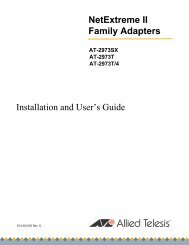
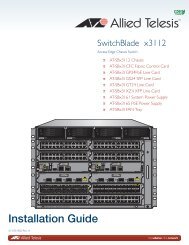
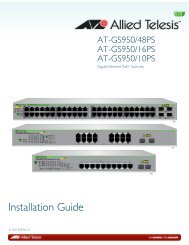
![AT-8100L/8POE-E [Rev B] - Allied Telesis](https://img.yumpu.com/25714603/1/190x245/at-8100l-8poe-e-rev-b-allied-telesis.jpg?quality=85)
